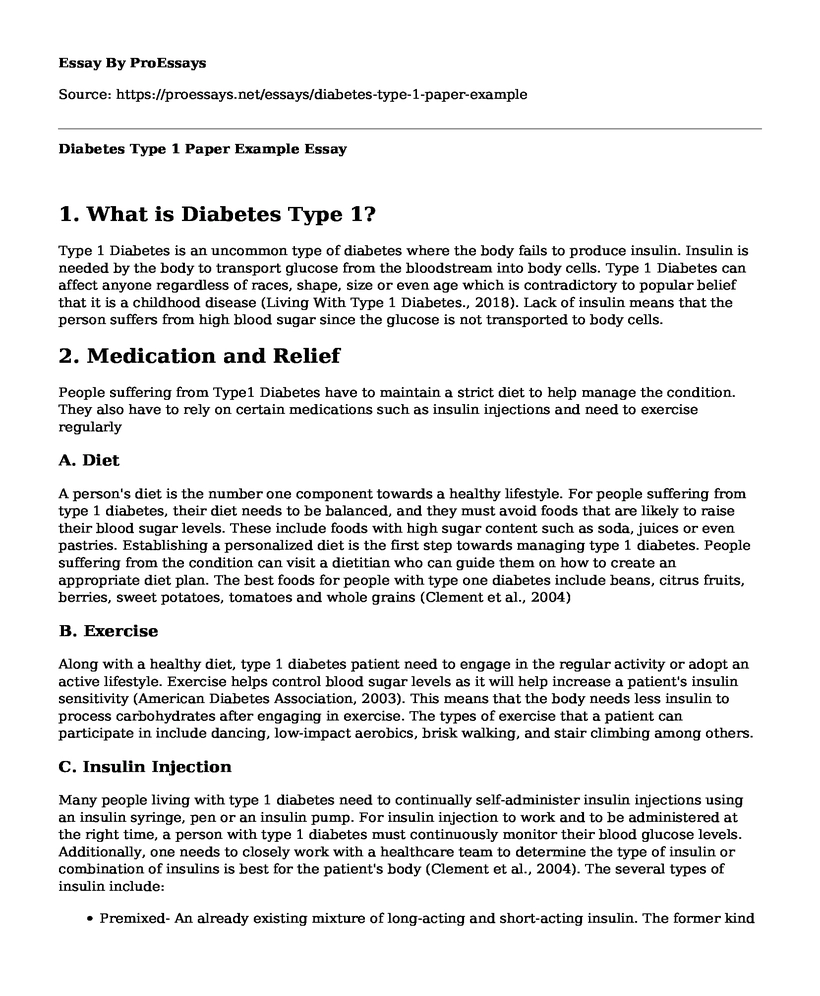1. What is Diabetes Type 1?
Type 1 Diabetes is an uncommon type of diabetes where the body fails to produce insulin. Insulin is needed by the body to transport glucose from the bloodstream into body cells. Type 1 Diabetes can affect anyone regardless of races, shape, size or even age which is contradictory to popular belief that it is a childhood disease (Living With Type 1 Diabetes., 2018). Lack of insulin means that the person suffers from high blood sugar since the glucose is not transported to body cells.
2. Medication and Relief
People suffering from Type1 Diabetes have to maintain a strict diet to help manage the condition. They also have to rely on certain medications such as insulin injections and need to exercise regularly
A. Diet
A person's diet is the number one component towards a healthy lifestyle. For people suffering from type 1 diabetes, their diet needs to be balanced, and they must avoid foods that are likely to raise their blood sugar levels. These include foods with high sugar content such as soda, juices or even pastries. Establishing a personalized diet is the first step towards managing type 1 diabetes. People suffering from the condition can visit a dietitian who can guide them on how to create an appropriate diet plan. The best foods for people with type one diabetes include beans, citrus fruits, berries, sweet potatoes, tomatoes and whole grains (Clement et al., 2004)
B. Exercise
Along with a healthy diet, type 1 diabetes patient need to engage in the regular activity or adopt an active lifestyle. Exercise helps control blood sugar levels as it will help increase a patient's insulin sensitivity (American Diabetes Association, 2003). This means that the body needs less insulin to process carbohydrates after engaging in exercise. The types of exercise that a patient can participate in include dancing, low-impact aerobics, brisk walking, and stair climbing among others.
C. Insulin Injection
Many people living with type 1 diabetes need to continually self-administer insulin injections using an insulin syringe, pen or an insulin pump. For insulin injection to work and to be administered at the right time, a person with type 1 diabetes must continuously monitor their blood glucose levels. Additionally, one needs to closely work with a healthcare team to determine the type of insulin or combination of insulins is best for the patient's body (Clement et al., 2004). The several types of insulin include:
- Premixed- An already existing mixture of long-acting and short-acting insulin. The former kind of insulin manages insulin blood-sugar throughout the day while the latter is used to stabilize blood sugar levels after meals (Insulin Types and Usage - JDRF., 2018).
- Short-Acting - Taken thirty minutes before the meal and can be used together with long-acting insulin for type 1 diabetes management.
- Intermediate-Acting- Manages blood-sugar level for approximately half a day or night depending on the time it is administered.
- Long-Acting - Combined with rapid or short-acting insulin to manage blood sugar levels
- Rapid-Acting - Taken before a meal or snack to offset the intake of carbohydrate.
4. Administering Insulin
A. Injections
Needed throughout the day to administer either rapid or short-acting insulin or a combination of both.
Injections are administered at the buttocks, thighs, abdomen or upper arms.
B. Pumps
Can be used to administer insulin throughout the day or insulin in large amounts to decrease glucose levels.
C. Artificial Pancreas
A hybrid closed-loop system connected to the body and that requires minimal user intervention.
References
American Diabetes Association. (2003). Physical activity/exercise and diabetes mellitus. Diabetes Care, 26(suppl 1), s73-s77.
Clement, S., Braithwaite, S. S., Magee, M. F., Ahmann, A., Smith, E. P., Schafer, R. G., & Hirsch, I. B. (2004). Management of diabetes and hyperglycemia in hospitals. Diabetes Care, 27(2), 553-591.
Insulin Types and Usage - JDRF. (2018). Retrieved from https://www.jdrf.org/about/what-is-t1d/insulin/Living With Type 1 Diabetes. (2018). Retrieved from http://www.diabetes.org/living-with-diabetes/recently-diagnosed/living-with-type-1-diabetes.html
Cite this page
Diabetes Type 1 Paper Example. (2022, Aug 18). Retrieved from https://proessays.net/essays/diabetes-type-1-paper-example
If you are the original author of this essay and no longer wish to have it published on the ProEssays website, please click below to request its removal:
- Research Proposal Example: Abortion Medicine Market in South Africa
- Research Paper on Health Effects of Low-Carbohydrate Diets Summary
- Theories and Code of Ethics in Practice Essay
- The Olympics of International Financial Institutions' Projects
- Essay Example on Canada's Drug Crisis: The Fight Against Opioid Abuse and Illegal Supply
- Essay Sample on Robotic Surgery: Improved Control, Flexibility & Precision.
- Essay Example on Public Health Nurses in the Face of a Pandemic







